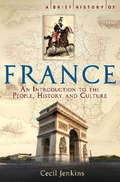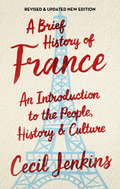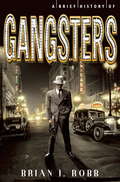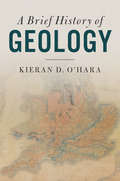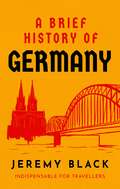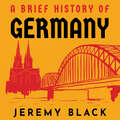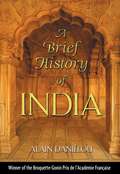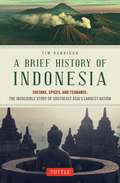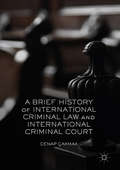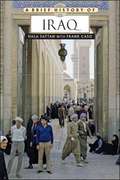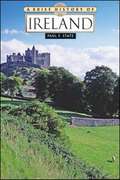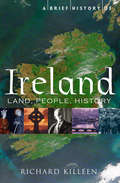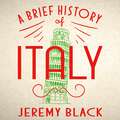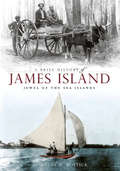- Table View
- List View
A Brief History of France, Revised and Updated: An Introduction To The People, History And Culture (Brief Histories )
by Cecil JenkinsWhen we think of France we often evoke images of fine food and wine, the elegant boulevards of Paris, the chic beaches of St Tropez. Yet, as the largest country in Europe, it is a place of huge diversity. The idea of 'Frenchness' emerged from over 2000 years of history and it is a riveting story from Roman conquest to the present day. Cecil Jenkins tells the story of the formation of this nation through its people, great events and culture. Through this narrative he charts why the French began to see themselves as so different from the rest of Europe and why, today, they face the same problems of identity as many other nations.
A Brief History of France: An Introduction To The People, History And Culture (Brief Histories Ser.)
by Cecil JenkinsWhen we think of France, we tend think of fine food and wine, the elegant boulevards of Paris or the chic beaches of St Tropez. Yet, as the largest country in Europe, France is home to extraordinary diversity. The idea of 'Frenchness' emerged through 2,000 years of history and it is this riveting story, from the Roman conquest of Gaul to the present day, that Cecil Jenkins tells: of the forging of this great nation through its significant people and events and and its fascinating culture. As he unfolds this narrative, Jenkins shows why the French began to see themselves as so different from the rest of Europe, but also why, today, the French face the same problems with regard to identity as so many other European nations.
A Brief History of Gangsters (Brief History)
by Brian J. RobbThe romanticised American gangster of the Prohibition era has proved an enduringly popular figure. Even today, names like Al Capone and Lucky Luciano still resonate. <P><P>Robb explores the histories of key figures, from gangs in the Old West, through Prohibition and the Great Depression, to the likes of John Gotti and Frank Lucas in the 1970s and 1980s. He also looks at the gangster in popular culture, in hit TV series such as Boardwalk Empire. <P>Although the focus is strongly on the archetypal American gangster, Robb also examines gangsters around the world, including the infamous Kray twins in London, French crime kingpin Jacques Mesrine, the Mafia Dons of Sicily, and the rise of notorious Serbian and Albanian gangs. Infamous Australian outlaw Ned Kelly makes an appearance, as does Colombian drug lord Pablo Escobar, while other sections provide details of the Chinese Triads and the Yakuza in Japan. Robb also explores the gangster in popular culture, especially in film and television.
A Brief History of Geology
by Kieran D. O’HaraGeology as a science has a fascinating and controversial history. <P><P>Kieran D. O'Hara's book provides a brief and accessible account of the major events in the history of geology over the last two hundred years, from early theories of Earth structure during the Reformation, through major controversies over the age of the Earth during the Industrial Revolution, to the more recent twentieth-century development of plate tectonic theory, and on to current ideas concerning the Anthropocene. <P>Most chapters include a short 'text box' providing more technical and detailed elaborations on selected topics. The book also includes a history of the geology of the Moon, a topic not normally included in books on the history of geology. The book will appeal to students of Earth science, researchers in geology who wish to learn more about the history of their subject, and general readers interested in the history of science. <P> Places geology in a wider context of the history of science in general, <P> Sixty figures explain historically important diagrams, <P> Includes a history of the geology of the Moon, which is not normally included in books on the history of geology.
A Brief History of Germany: Indispensable for Travellers (Brief Histories)
by Jeremy BlackThe history of Germany is intricately woven. Threaded in time through its struggles and triumphs with religion, industrialisation, enlightenment, politics, unification, and war.In A Brief History of Germany, Jeremy Black questions how the Germany we know today came to be, chronicling the events that shaped its past, present and future in a fascinating new way.From the fall of Rome in the 1500s to the enlightenment in the 1700s, from World War I and World War II to Germany post-unification, Black's writing will unlock the places and people that formed Germany and enrich your visit with stories of its society and culture.Concise yet explorative, A Brief History of Germany is an astonishing work from a renowned UK historian. Whether you are a long-term reader of Black's expansive history work or are interested in learning more ahead of a short city break or longer trip, this intriguing look at the history of Germany is an essential read.
A Brief History of Germany: Indispensable for Travellers (Brief Histories)
by Jeremy BlackThe history of Germany is intricately woven. Threaded in time through its struggles and triumphs with religion, industrialisation, enlightenment, politics, unification, and war.In A Brief History of Germany, Jeremy Black questions how the Germany we know today came to be, chronicling the events that shaped its past, present and future in a fascinating new way.From the fall of Rome in the 1500s to the enlightenment in the 1700s, from World War I and World War II to Germany post-unification, Black's writing will unlock the places and people that formed Germany and enrich your visit with stories of its society and culture.Concise yet explorative, A Brief History of Germany is an astonishing work from a renowned UK historian. Whether you are a long-term reader of Black's expansive history work or are interested in learning more ahead of a short city break or longer trip, this intriguing look at the history of Germany is an essential read.
A Brief History of Germany: Indispensable for Travellers (Brief Histories)
by Jeremy BlackThe history of Germany is intricately woven. Threaded in time through its struggles and triumphs with religion, industrialisation, enlightenment, politics, unification, and war.In A Brief History of Germany, Jeremy Black questions how the Germany we know today came to be, chronicling the events that shaped its past, present and future in a fascinating new way.From the fall of Rome in the 1500s to the enlightenment in the 1700s, from World War I and World War II to Germany post-unification, Black's writing will unlock the places and people that formed Germany and enrich your visit with stories of its society and culture.Concise yet explorative, A Brief History of Germany is an astonishing work from a renowned UK historian. Whether you are a long-term reader of Black's expansive history work or are interested in learning more ahead of a short city break or longer trip, this intriguing look at the history of Germany is an essential read.
A Brief History of Henry VIII: King, Reformer and Tyrant
by Derek WilsonHenry VIII changed the course of English life more completely than any monarch since the Conquest. In the portraits of Holbein, Henry Tudor stands proud as one of the most powerful figures in renaissance Europe. But is the portrait just a bluff? In his new book Derek Wilson explores the myths behind the image of the Tudor Lion. He was the monarch that delivered the Reformation to England yet Luther called him 'A fool, a liar and a damnable rotten worm'. As a young man he gained a reputation as an intellectual and fair prince yet he ruled the nation like a tyrant. He treated his subjects as cruelly as he treated his wives. Based on a wealth of new material and a life time's knowledge of the subject Derek Wilson exposes a new portrait of a much misunderstood King.
A Brief History of Henry VIII: King, Reformer and Tyrant (Brief Histories)
by Mr Derek WilsonHenry VIII changed the course of English life more completely than any monarch since the Conquest. In the portraits of Holbein, Henry Tudor stands proud as one of the most powerful figures in renaissance Europe. But is the portrait just a bluff?In his brilliant new history of the life of Henry VIII, Derek Wilson explores the myths behind the image of the Tudor Lion. He was the monarch that delivered the Reformation to England yet Luther called him 'A fool, a liar and a damnable rotten worm'. As a young man he gained a reputation as an intellectual and fair prince yet he ruled the nation like a tyrant. He treated his subjects as cruelly as he treated his wives. Based on a wealth of new material and a lifetime's knowledge of the subject Derek Wilson exposes a new portrait of a much misunderstood King.PRAISE FOR DEREK WILSON'S PREVIOUS WORKS:The Uncrowned Kings of England: 'Stimulating and authorative' - John Guy'Masterly. [Wilson] has a deep understanding of . . . characters, reaching out accross the centuries' - Sunday TimesHans Holbein: Portrait of an Unknown Man:'Fascinating' Sarah Bradford, Daily Telegraph'Highly readable . . . The most accurate and vivid portrayal to date' Alison Weir
A Brief History of High-Speed Rail
by Qizhou Hu Siyuan QuThis book introduces the basic knowledge, concepts, terms and development process of high-speed rail (HSR) and summarizes its main achievements at this stage. It mainly expounds the connotation of high-speed rail to readers from two different aspects of theory and technology. The book explains the development process of high-speed rail in terms of time: yesterday's wheel rail high-speed rail, today's maglev high-speed rail and tomorrow's super high-speed rail; and also spatially, making a comparative analysis of the development around the world.This book can be used as a reading material for scientific researchers, engineering technicians, management workers, teachers and students of colleges and universities as well as high-speed railfans.
A Brief History of History
by Jeremy BlackIn A Brief History of History, acclaimed historian Jeremy Black seeks to reinvigorate and redefine our ideas about history. The stories we tell about the past are a crucial aspect of all cultures. However, while the traditional storytelling process—what we think of as "history" in the proper sense—is useful, it is also misleading, not least because it leads to the repetition of bias and misinformation. Black suggests that the conventional idea of history and historians is constructed too narrowly, as it fails to engage with the broad nature of lived experience. By focusing on a singular idea or story within the history being explored, we fail to understand the interconnectivity of the everyday experience. A Brief History of History challenges accepted norms of the historical perspective and offers a view of human history that will surprise many and (perhaps) infuriate some. But above all, it is a history of historians written for this moment in time, a time when the traditional Eurocentric approach to history now appears wholly inappropriate.
A Brief History of Human Culture in the 20th Century (China Academic Library)
by Qi XinThis book examines the cultural concepts that guided the development of the “age of mankind”— the changes that took place in historical, philosophical, scientific, religious, literary, and artistic thought in the 20th century. It discusses a broad range of major topics, including the spread of commercial capitalism; socialist revolutions; the two world wars; anti-colonialist national liberation movements; scientific progress; the clashes and fusion of Eastern and Western cultures; globalization; women’s rights movements; mass media and entertainment; the age of information and the digital society. The combination of cultural phenomena and theoretical descriptions ensures a unity of culture, history and logic. Lastly, the book explores the enormous changes in lifestyles and the virtualized future, revealing cultural characteristics and discussing 21st -century trends in the context of information technology, globalization and the digital era.
A Brief History of Image Science and Technology in China
by Congyao HanThis book, within the vision of the study on the image history, clearly manifests the development of Chinese image science and technology of over 2000 years based on compendium, while having briefly sorted out expositions by scientists since ancient times in China, demonstrates the spiritual course, ideas of thinking and forms of life and reveales profound humane ideas, basis of sentiments and styles of the spirit featured by Chinese image culture. The historic outline of images is clear-cut along with authenticated inter-attestation for clues of images and texts. Historic facts concerning images are ecologically diversified, while historic documents about images are properly chosen, in addition to the integration between liberal arts and science and perfect combination between images and texts. Blessed with nice integration between images and texts, this book serves as reference to experts, scholars, undergraduates and postgraduates related to the study on image history, history of science and technology, study of history and news communication.
A Brief History of India
by Alain Daniélou Kenneth F. HurryDaniélou's powerful rebuttal to the conventional view of India's history, which calls for a massive reevaluation of the history of humanity• Explores historical occurrences from each major time period starting with the first appearance of man 30,000 years ago• Couples the clarity and perspective of an outsider with the unique and specific knowledge of an insider• By the internationally recognized Hindu scholar and translator of The Complete Kama Sutra (200,000 copies sold)Alain Daniélou approaches the history of India from a new perspective--as a sympathetic outsider, yet one who understands the deepest workings of the culture. Because the history of India covers such a long span of time, rather than try to create an exhaustive chronology of dates and events, Daniélou instead focuses on enduring institutions that remain constant despite the ephemeral historical events that occur. His selections, synthesis, and narration create a thoroughly engaging and readable journey through time, with a level of detail and comprehensiveness that is truly a marvel.Because of the continuity of its civilization, its unique social system, and the tremendous diversity of cultures, races, languages, and religions that exist in its vast territory, India is like a history museum. Its diverse groups maintained their separate identities and never fully supplanted the culture and knowledge of their predecessors. Even today one may encounter in India primitive Stone Age people whose technology has remained at what is considered prehistoric levels. Thus Daniélou's examination of India reveals not only the diversity and historical events and trends of that country, but also the history of all mankind. Through Daniélou's history of India we learn from whence we came, what we have discovered over the years in the fields of science, arts, technology, social structures, religions, and philosophical concepts, and what the future may hold for us.
A Brief History of Indonesia
by Tim HanniganSultans, Spices, and Tsunamis: The Incredible Story of the World's Largest Archipelago Indonesia is by far the largest nation in Southeast Asia and has the fourth largest population in the world after the United States. Indonesian history and culture are especially relevant today as the Island nation is an emerging power in the region with a dynamic new leader. It is a land of incredible diversity and unending paradoxes that has a long and rich history stretching back a thousand years and more. Indonesia is the fabled "Spice Islands" of every school child's dreams—one of the most colorful and fascinating countries in history. These are the islands that Europeans set out on countless voyages of discovery to find and later fought bitterly over in the 15th, 16th and 17th centuries. This was the land that Christopher Columbus sought and Magellan actually reached and explored. One tiny Indonesian island was even exchanged for the island of Manhattan in 1667! This fascinating book tells the story of Indonesia as a narrative of kings, traders, missionaries, soldiers and revolutionaries, featuring stormy sea crossings, fiery volcanoes, and the occasional tiger. It recounts the colorful visits of foreign travelers who have passed through these shores for many centuries—from Chinese Buddhist pilgrims and Dutch adventurers to English sea captains and American movie stars. For readers who want an entertaining introduction to Asia's most fascinating country, this is delightful reading.
A Brief History of Indonesia
by Tim HanniganSultans, Spices, and Tsunamis: The Incredible Story of the World's Largest ArchipelagoIndonesia is by far the largest nation in Southeast Asia and has the fourth largest population in the world after the United States. Indonesian history and culture are especially relevant today as the Island nation is an emerging power in the region with a dynamic new leader. It is a land of incredible diversity and unending paradoxes that has a long and rich history stretching back a thousand years and more.Indonesia is the fabled "Spice Islands" of every school child's dreams-one of the most colorful and fascinating countries in history. These are the islands that Europeans set out on countless voyages of discovery to find and later fought bitterly over in the 15th, 16th and 17th centuries. This was the land that Christopher Columbus sought and Magellan actually reached and explored. One tiny Indonesian island was even exchanged for the island of Manhattan in 1667!This fascinating book tells the story of Indonesia as a narrative of kings, traders, missionaries, soldiers and revolutionaries, featuring stormy sea crossings, fiery volcanoes, and the occasional tiger. It recounts the colorful visits of foreign travelers who have passed through these shores for many centuries-from Chinese Buddhist pilgrims and Dutch adventurers to English sea captains and American movie stars. For readers who want an entertaining introduction to Asia's most fascinating country, this is delightful reading.
A Brief History of International Criminal Law and International Criminal Court
by Cenap ÇakmakThis book offers a historical presentation of how international criminal law has evolved from a national setting to embodying a truly international outlook. As a growing part of international law this is an area that has attracted growing attention as a result of the mass atrocities and heinous crimes committed in different parts of the world. Çakmak pays particular attention to how the first permanent international criminal court was created and goes on to show how solutions developed to address international crimes have remained inadequate and failed to restore justice. Calling for a truly global approach as the only real solution to dealing with the most severe international crimes, this text will be of great interest to scholars of criminal justice, political science, and international relations.
A Brief History of Iraq
by Hala Fattah Hala Mundhir Fattah Frank CasoFattah (world history, American Community School, Jordan) and Caso (writer and editor) offer a comprehensive view of Iraq, a region once far from the minds of almost everyone but its residents, and now a daily source of news and debate. The book begins with Iraq's Mesopotamian origins and concludes with the 2003 U.S. invasion and the end of Saddam Hussein. It explores the country in terms of its ethnicities, religions and sects, national groups, adaptation, acculturation, interaction, and growth. Annotation ©2009 Book News, Inc., Portland, OR (booknews.com)
A Brief History of Ireland
by Paul E. StateA Brief History of Ireland provides a broad narrative of the central events that have shaped the country, from the arrival of the Celts to recent economic developments that have brought booming prosperity and social change. The geographical proximity of Great Britain and a strained relationship between the peoples of the two isles had a profound impact on Irish development, culminating in the forced absorption of Ireland into Great Britain in 1801. The Irish struggled to retain their separate ethnic identity defined by a distinctive language and cultural traditions and their Roman Catholic faith-and resolved to win independence. For more than a century, Ireland became hostage to the religious discord, outbreaks of armed rebellion, social and political instability, and famines that plagued the nation and its people. The Irish managed to survive, and, ultimately, they succeeded in securing their dream of national self-identity. Now a democratic and prosperous nation open to the world, modern Ireland is a synthesis of both Irish and English heritages.
A Brief History of Ireland (Brief Histories )
by Richard KilleenFrom the dawn of history to the decline of the Celtic Tiger - how Ireland has been shaped over the centuries.Ireland has been shaped by many things over the centuries: geography, war, the fight for liberty. A Brief History of Ireland is the perfect introduction to this exceptional place, its people and its culture.Ireland has been home to successive groups of settlers - Celts, Vikings, Normans, Anglo-Scots, Huguenots. It has imported huge ideas, none bigger than Christianity which it then re-exported to Europe after the fall of the Roman Empire. In the Tudor era it became the first colony of the developing English Empire. Its fraught and sometimes brutal relationship with England has dominated its modern history. Killeen argues that religion was decisive in all this: Ireland remained substantially Catholic, setting it at odds with the larger island culturally, religiously and politically. But its own culture and identity have stayed strong, most obviously in literature with a magnificent tradition of writing from the Book of Kells to the modern masters: Joyce, Yeats, Beckett and Heaney.
A Brief History of Ireland (Brief Histories)
by Richard KilleenFrom the dawn of history to the decline of the Celtic Tiger - how Ireland has been shaped over the centuries.Ireland has been shaped by many things over the centuries: geography, war, the fight for liberty. A Brief History of Ireland is the perfect introduction to this exceptional place, its people and its culture.Ireland has been home to successive groups of settlers - Celts, Vikings, Normans, Anglo-Scots, Huguenots. It has imported huge ideas, none bigger than Christianity which it then re-exported to Europe after the fall of the Roman Empire. In the Tudor era it became the first colony of the developing English Empire. Its fraught and sometimes brutal relationship with England has dominated its modern history. Killeen argues that religion was decisive in all this: Ireland remained substantially Catholic, setting it at odds with the larger island culturally, religiously and politically. But its own culture and identity have stayed strong, most obviously in literature with a magnificent tradition of writing from the Book of Kells to the modern masters: Joyce, Yeats, Beckett and Heaney.
A Brief History of Italy: Indispensable for Travellers
by Jeremy BlackDespite the Roman Empire's famous 500-year reign over Europe, parts of Africa and the Middle East, Italy does not have the same long national history as states such as France or England. Divided for much of its history, Italy's regions have been, at various times, parts of bigger, often antagonistic empires, notably those of Spain and Austria. In addition, its challenging and varied terrain made consolidation of political control all the more difficult. This concise history covers, in very readable fashion, the formative events in Italy's past from the rise of Rome, through a unified country in thrall to fascism in the first half of the twentieth century right up to today. The birthplace of the Renaissance and the place where the Baroque was born, Italy has always been a hotbed of culture. Within modern Italy country there is fierce regional pride in the cultures and identities that mark out Tuscany, Rome, Sicily and Venice to name just a few of Italy's many famous regions. Jeremy Black draws on the diaries, memoirs and letters of historic travellers to Italy to gain insight into the passions of its people, first chronologically then regionally. In telling Italy's story, Black examines what it is that has given Italians such cultural clout - from food and drink, music and fashion, to art and architecture - and explores the causes and effects of political events, and the divisions that still exist today.
A Brief History of Italy: Indispensable for Travellers
by Jeremy Black'Jeremy Black skilfully sketches social, cultural and political trends' - Christina Hardyment, Times audiobook of the week'A remarkable mixture of cold history, wide culture and personal experience'Ciro Paoletti, Secretary General of the Italian Commission of Military HistoryDespite the Roman Empire's famous 500-year reign over Europe, parts of Africa and the Middle East, Italy does not have the same long national history as states such as France or England. Divided for much of its history, Italy's regions have been, at various times, parts of bigger, often antagonistic empires, notably those of Spain and Austria. In addition, its challenging and varied terrain made consolidation of political control all the more difficult. This concise history covers, in very readable fashion, the formative events in Italy's past from the rise of Rome, through a unified country in thrall to fascism in the first half of the twentieth century right up to today. The birthplace of the Renaissance and the place where the Baroque was born, Italy has always been a hotbed of culture. Within modern Italy country there is fierce regional pride in the cultures and identities that mark out Tuscany, Rome, Sicily and Venice to name just a few of Italy's many famous regions. Jeremy Black draws on the diaries, memoirs and letters of historic travellers to Italy to gain insight into the passions of its people, first chronologically then regionally. In telling Italy's story, Black examines what it is that has given Italians such cultural clout - from food and drink, music and fashion, to art and architecture - and explores the causes and effects of political events, and the divisions that still exist today.
A Brief History of Italy: Indispensable for Travellers
by Jeremy Black'Jeremy Black skilfully sketches social, cultural and political trends' - Christina Hardyment, Times audiobook of the week'A remarkable mixture of cold history, wide culture and personal experience'Ciro Paoletti, Secretary General of the Italian Commission of Military HistoryDespite the Roman Empire's famous 500-year reign over Europe, parts of Africa and the Middle East, Italy does not have the same long national history as states such as France or England. Divided for much of its history, Italy's regions have been, at various times, parts of bigger, often antagonistic empires, notably those of Spain and Austria. In addition, its challenging and varied terrain made consolidation of political control all the more difficult. This concise history covers, in very readable fashion, the formative events in Italy's past from the rise of Rome, through a unified country in thrall to fascism in the first half of the twentieth century right up to today. The birthplace of the Renaissance and the place where the Baroque was born, Italy has always been a hotbed of culture. Within modern Italy country there is fierce regional pride in the cultures and identities that mark out Tuscany, Rome, Sicily and Venice to name just a few of Italy's many famous regions. Jeremy Black draws on the diaries, memoirs and letters of historic travellers to Italy to gain insight into the passions of its people, first chronologically then regionally. In telling Italy's story, Black examines what it is that has given Italians such cultural clout - from food and drink, music and fashion, to art and architecture - and explores the causes and effects of political events, and the divisions that still exist today.
A Brief History of James Island: Jewel of the Sea Islands (Brief History)
by Douglas W. BostickIn this engaging volume, local historian Douglas Bostick reveals the unacknowledged history of the second community in South Carolina, settled in 1671. Whether investigating prehistoric clues about Native American life before European settlement, detailing the history of agriculture and the reign of King Cotton, following armies from multiple wars or chronicling the triumph of equality on the greens of Charleston's Municipal Golf Course, Bostick tells the story of James Island as only a native son can. Join Bostick as he brings this small jewel of an island out of Charleston's shadow and into the light of its own rich, historic assets.
